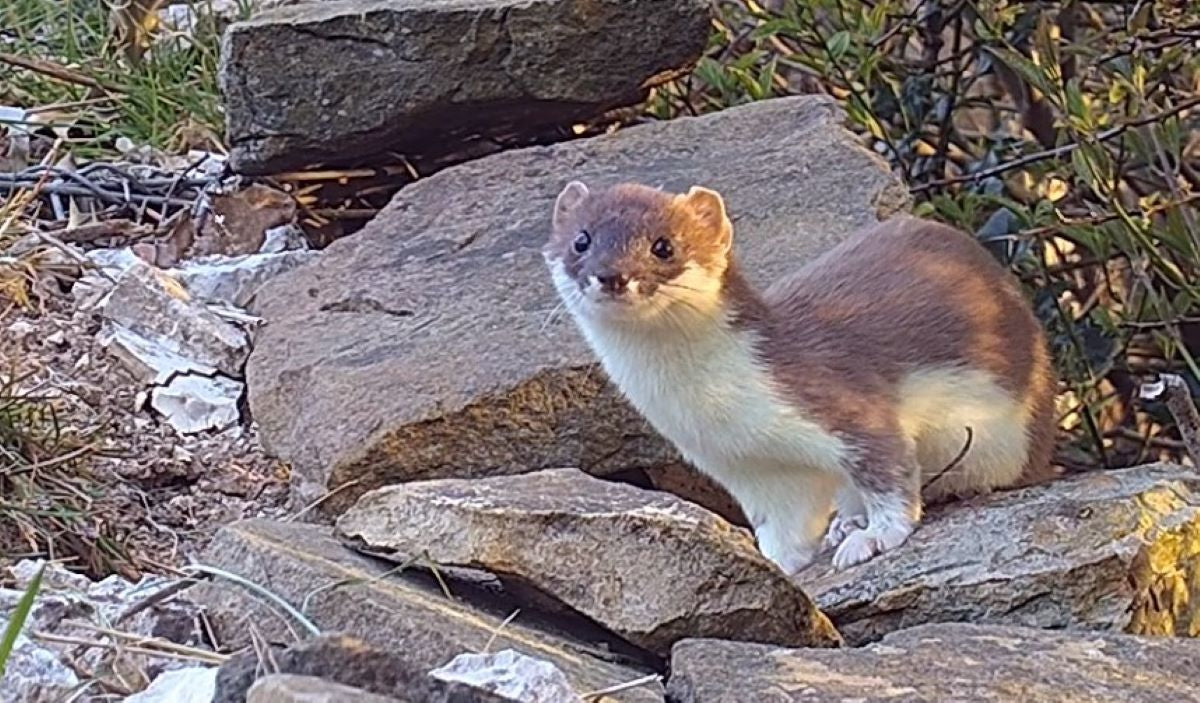This blog post is all about the fascinating, if somewhat alarming, breeding habits of stoats and is told through the story of a new stoat mum in my garden in North Yorkshire, named Hazel. Hazel is the daughter of Bandita, a stoat mum who has brought up generations of stoats here. Bandita found fame after featuring in a TV documentary made by BBC Natural World, Weasels: Feisty and Fearless: Click here to read her story.
Stoats give birth in spring
I first spotted that one of the stoats in the garden was pregnant in late March, after noticing her swollen belly via hidden cameras. Stoats are slim and long and she looked as though she had swallowed a light bulb! Stoats usually give birth in late March, or early April and so I had been on the lookout for any sign of breeding and was keeping a close eye on her. Sure enough, after a few weeks, I could see that her belly had slimmed down.
Stoat nest secrets
Stoats move very fast and I had to watch her movements carefully on the cameras to track down the location of her hidden nest. It was soon clear that she kept returning to the same spot, close to where she herself was born last year. And before long I spotted her carrying grass into the spot. I decided to leave some grass out, especially for her and watched closely to see what happened. She waited a day or two, possibly the grass had my scent on it, before tucking it under her front paws and dragging it down into her nest.
Male stoats and kits
It wasn't long before a male stoat, attracted by her scent, followed her into the nest to mate her. You can tell males by the fact that they are considerably bigger than females. The average female weighs around 240gs, whilst a male can weigh up to 380gs. Males will also take advantage of any female kits inside the nest and mate them too, despite these babies being just two weeks old! This can seem a little alarming to us, humans, but it guarantees the stoat passes on his genes. A sure sign that this female has been mated is the wet mark on the back of her neck, where she had been grasped by the male in what can seem like a brutal tryst.
Crossing stoat territories to mate
Female stoats can have territories of up to 50 acres, depending on food supplies, and males will range across these to try and mate as many females as possible. Interestingly, in New Zealand, males have been reported to swim 5kms at a time to reach females on islands out at sea.
Delayed implantation
A female can be mated a week after she has given birth to a litter but she won't give birth to the new litter until the following year, in late March or early April. This is due to a process known as 'delayed implantation'. The kits will also delay implantation until the following spring.
Stoat nest moves
This young family will remain hidden underground for the next few weeks, however, stoat mums often relocate to new nests in order to keep their young safe so we may see them on the cameras earlier. When on the move, stoat mums grasp their kits in their mouths and run with them, fast. Unsurprisingly, kits get dropped and much of my wildlife rescue work involves rehabilitating these young animals. Click here to read my blog post about a rescue stoat named Whisper
Stoat litters
Stoats generally have litters of seven, although I have heard reports of up to 13, when they are this large many don't survive. Last year Bandita had seven kits and I'm expecting roughly the same number from Hazel. It is really fun watching these youngsters grow up. They are really very playful creatures and in recent years I've donated my own children's trampoline for them to play on!
Stoats at Fotherdale
I've watched generations of stoats grow up here at Fotherdale. Click here to read more about some of the fabulous stoat characters I have followed Below is a recording of a live broadcast all about stoat breeding habits. It includes clips of Hazel as a young kit and follows the fascinating story of how stoats mate.













